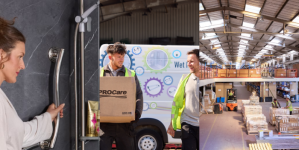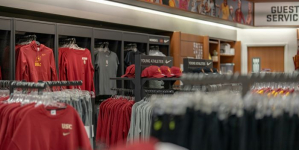-
AI startup Onton raises $7.5M to reinvent the way the world discovers and decides what to buy - November 26, 2025
-
Forklift Market Positions for Recovery as Confidence Expected to Build from 2026 - November 26, 2025
-
PROCare achieves 300% order capacity increase and 99% picking accuracy with Forterro’s ERP solution, Orderwise - November 26, 2025
-
DHL boosts operational efficiency and customer communications with HappyRobot’s AI Agents - November 25, 2025
-
STENA LINE TEAMS UP WITH CAMERA TELEMATICS TO DRIVE SAFETY IMPROVEMENTS AT IRISH SEA PORTS - November 25, 2025
-
Another design award for Toyota’s lithium-ion Traigo_i counterbalanced forklift - November 21, 2025
-
Stuut Technologies Raises $29.5 Million Series A Led by Andreessen Horowitz to Automate Accounts Receivable Work - November 20, 2025
-
INCREASED DIGITAL INVESTMENT REQUIRED TO KEEP PACE WITH 2026 CUSTOMS CHANGES - November 19, 2025
-
FULFILMENT SOLUTIONS FOR SPORTS MERCHANDISE: KEEPING OUR EYE ON THE GAME - November 19, 2025
-
COMPLEX, COSTLY & CONFUSING – THE END OF DE MINIMIS - November 19, 2025
With e-commerce booming, optimising the delivery process is not just for Christmas.
Prasad Satyavolu, Chief Digital Officer, Manufacturing, Logistics, Energy & Utilities, Cognizant
The festive season puts an enormous amount of additional pressure on supply chains and logistics. So much so that the likes of Argos have opened new fulfilment centres to keep up with the swarm of expected same day deliveries, whilst ASOS has gone even further by planning to be the first in the UK to offer same-day-returns, just in time for Christmas. This will be ground-breaking for consumers, who will be able to book, via the retailer’s app, collection of unwanted items at a time and place that suits them. In order for retailers to optimise their supply chain strategies, a lot of planning and investment has been put into these new initiatives to ensure they can actually deliver on their promises.
Often around peak periods such as Christmas, retailers and logistics companies look to hire additional manpower to cope with extra deliveries. While this will likely always be the case for several years to come, support can also be provided by optimising supply chain systems and networks through technology to streamline fulfilment and delivery processes.
Businesses will need to be smarter in the way they work, to ensure these processes are as efficient as possible, or risk feeling the wrath of demanding consumers. So, what should they be considering to deal with an increase in orders during the pre-Christmas season?
Automation and voice recognition – In the warehouse itself, there are several key challenges that workers must deal with. These include high volumes of goods, the coordination of different areas within the warehouse, and locating multiple items within a short timeframe. Voice recognition can help make this process more efficient for the workforce. A continuous stream of Q&A between them and machine can help speed up processes, such as locating items. Instead of checking a handheld picking device for details, they get an answer straight away from the machine. Overall, voice recognition can support warehouse personnel, helping boost productivity and streamlining the production and packing process.
Next-gen robots – We will see many pilot technologies infiltrate mainstream processes, pioneered by the likes of Amazon and Google. For example, drones equipped with a camera will be able to read bar codes and manage inventory, reducing the need for manual labour and saving time. Delivering through drones will also become the leading edge of last-mile delivery.
Wearables – Augmented reality (AR) glasses are not just a consumer gimmick. Enterprise ready devices can enhance parts of the workforce’s job in the warehouse through automation. They can be adapted to include high-tech features that enable an employee to view a checklist of activities, call and video chat with colleagues, scan bar-codes to manage inventory and feed into ERP systems, even identify defective parts.
Perfect packing – While it may sound simple, the way firms load packages into lorries needs to be considered. If goods are packed in a haphazard way, it is very easy for parcels to be overlooked and delivery either delayed or not fulfilled. However, technology can be used to gain a holistic view of deliveries, allowing couriers to optimally pack and prepare parcels ready for drop off.
Vehicle analytics – While autonomous vehicles are not yet mainstream, businesses can already take advantage of real-time data via telematics to plan out routes and avoid situations that may slowdown delivery. Eventually, we will see the rise of sensor-embedded roads that will continuously gather data from passing vehicles and optimise this process further.
Off-the-shelf mobile devices – When hiring new staff, most businesses will need to train them in how to use proprietary hand-held devices. Training new employees – who may only be temporary if hired for peak periods – as well as maintaining devices and upgrading them, is less cost effective. Off-the-shelf mobile devices are much more intuitive to use than proprietary ones, as we use them in our everyday lives. Provided they are supported with a digital eco-system that connects them to the information they need in real-time, they are an effective way of managing deliveries.
With consumers mainly making purchasing decisions based on convenience, the race is on for retail businesses. Having an all singing, all dancing, slick website or app will no longer suffice as a differentiator. Speed of fulfilment is now the battlefield and companies cannot afford failures in the warehouse or in delivery services. With on-demand shopping becoming the norm, more and more businesses will feel the pressure to adhere to this trend too or risk losing out on customers. Companies should be implementing technologies and processes that will enable them to be more efficient all year round, and build agile infrastructure to cope during peak periods with great ease.

































